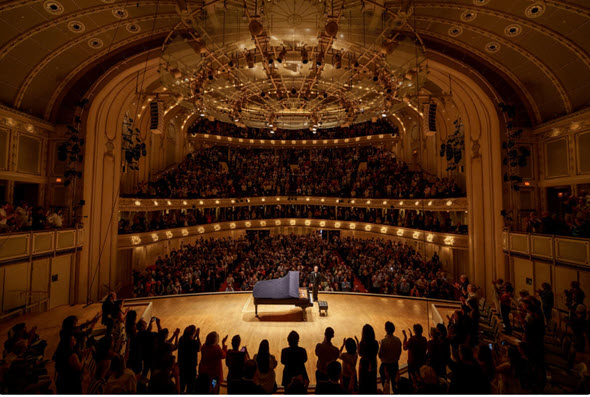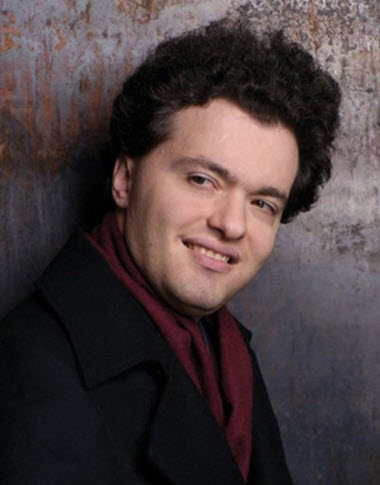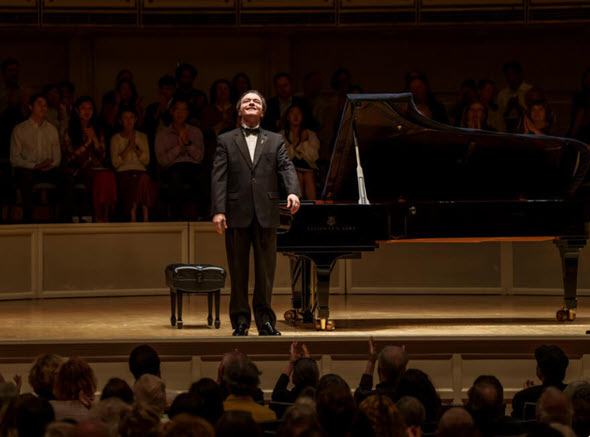Pianist Kissin, cheering throng of enthusiasts renew an annual celebration at Orchestra Hall
Review: Pianist Evgeny Kissin, May 19 at Orchestra Hall.
By Lawrence B. Johnson
Pianist Evgeny Kissin’s annual recitals in Chicago are unlike any other musical performance in the year at Orchestra Hall. When Kissin shows up, well, so does everybody else. These are not concerts, but Events. Witness the 52-year-old pianist’s latest appearance on May 19: Not only was the hall jam-packed, including the choral terrace, but three rows of tiered onstage seating immediately behind the piano also were filled end to end. Kissin is manifestly Chicago’s favorite visiting virtuoso, and for good reason. He may well be the greatest pianist in the world, and he never disappoints.
Kissin’s program this time had the look of core repertoire, but it also had a couple of intriguing wrinkles. He began with one of them, Beethoven’s Sonata in E minor, Op. 90, a work that occupies a kind of limbo between the last of the “middle-period” sonatas, No. 26 in E-flat, Op. 81a (“Les Adieux”), and the five “late” sonatas. Indeed, the two-movement Op. 90 Sonata seems to have a foot in both the lyrical world of “Les Adieux” and the radical domain of Beethoven’s later works.
What’s especially fascinating about the Sonata No. 27 in E minor is that it begins forward-looking with something of a clinical disposition, angular if not severe, then reverts in the closing movement to an open geniality that harkens back to “Les Adieux” — as if Beethoven, on the verge of a stylistic pivot, turned only halfway before reconsidering. Kissin made compelling work of the sonata’s opening movement, incisive and articulate, before going with the finale’s sparkling flow. Here was the pianist’s complete authority and range in microcosm: strength and clarity side by side with fluency and radiance.
A luminous reading of Chopin’s Nocturne in F-sharp minor, Op. 48, No. 2, spacious and immersive, provided a transition to the real counterweight to Beethoven – Chopin’s Fantasy in F minor, Op. 49. This searching, impulsive, indeed fantastical essay could just as well be labeled a ballad, so enthralling is its nebulous narrative. For the first time in his recital, Kissin flashed the sheer technical brilliance that can leave the comprehending ear at odds with the disbelieving eye – bedazzlement in the form of limpid poetry.
Ballads by that name ensued with a suite by the 21-year-old Brahms, his Four Ballades, Op. 10. With the nominal exception of No. 1, the four pieces cast in harmonic pairs – D minor/major, then B minor/major – are more about musical structure and evocative sonority than specific story-telling, more suggestive washes of color than line drawings. But the young Brahms’ originality is matched by his sure craftsmanship, and Kissin conjured each tableau with keen sensitivity as well airy grace and, in the B minor scherzo, frothy agility.
Prokofiev also was 21 when he composed his Piano Sonata No. 2 in D minor some 58 years later than those Brahms ballades, in 1912. Its remove from Brahms is more than a couple of generations; it is another world altogether: fierce, flinty, brash, self-assuredly brilliant. Which pretty well sums up Kissin’s heroic account of Prokofiev’s mischievous wizardry. The seventh of Prokofiev’s sonatas has long been the favorite of pianists. It was exhilarating to hear this much earlier work in the hands — and from the mind — of a pianist equal to the composer’s fearsome demands and scintillating wit.
The printed program never defines a Kissin recital. This knowing audience broke into rhythmic clapping at the close in high expectation of several encores. He’s often good for half a dozen; here he offered three gems: a sensuous turn with Chopin’s Mazurka in A minor, Op. 67, No. 4; a bang-up stentorian strut through the March from Prokofiev’s opera “The Love for Three Oranges” and a gentle embrace of Brahms’ Waltz in A-flat Major, Op. 39, No. 15 – the recital’s quiet exit line.





